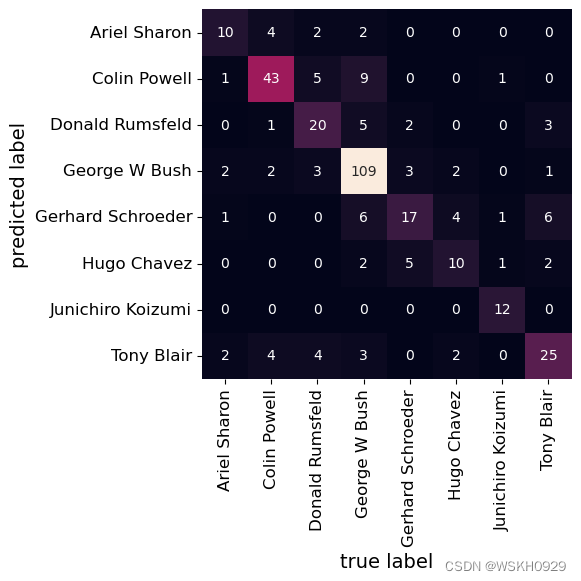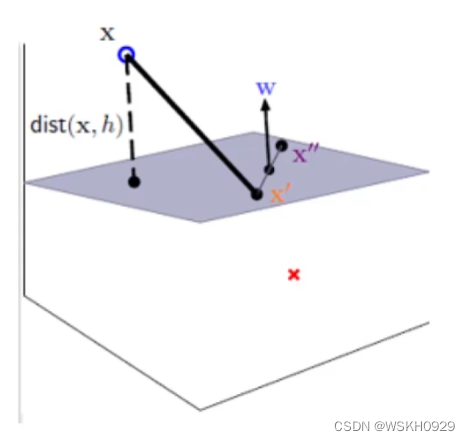【机器学习】Support Vertor Machine 支持向量机算法详解 + 数学公式推导 + Python代码实战
一、Support Vertor Machine 简介
支持向量机(Support Vector Machine, SVM)是一类按监督学习(supervised learning)方式对数据进行二元分类的广义线性分类器(generalized linear classifier),其决策边界是对学习样本求解的最大边距超平面(maximum-margin hyperplane)
它将实例的特征向量映射为空间中的一些点,SVM 的目的就是想要画出一条线,以 “最好地” 区分这两类点,以至如果以后有了新的点,这条线也能做出很好的分类。SVM 适合中小型数据样本、非线性、高维的分类问题。
SVM 最早是由 Vladimir N. Vapnik 和 Alexey Ya. Chervonenkis 在1963年提出,目前的版本(soft margin)是由 Corinna Cortes 和 Vapnik 在1993年提出,并在1995年发表。深度学习(2012)出现之前,SVM 被认为机器学习中近十几年来最成功,表现最好的算法。
二、Support Vertor Machine 详解
2.1 什么才是好的决策边界
要解决的问题:什么样的决策边界才是最好的呢?
答:决策边界离两个类别的最短距离和越远越好。如下图所示,Large Margin显然是更好的决策边界,因为它具有更强的容错性
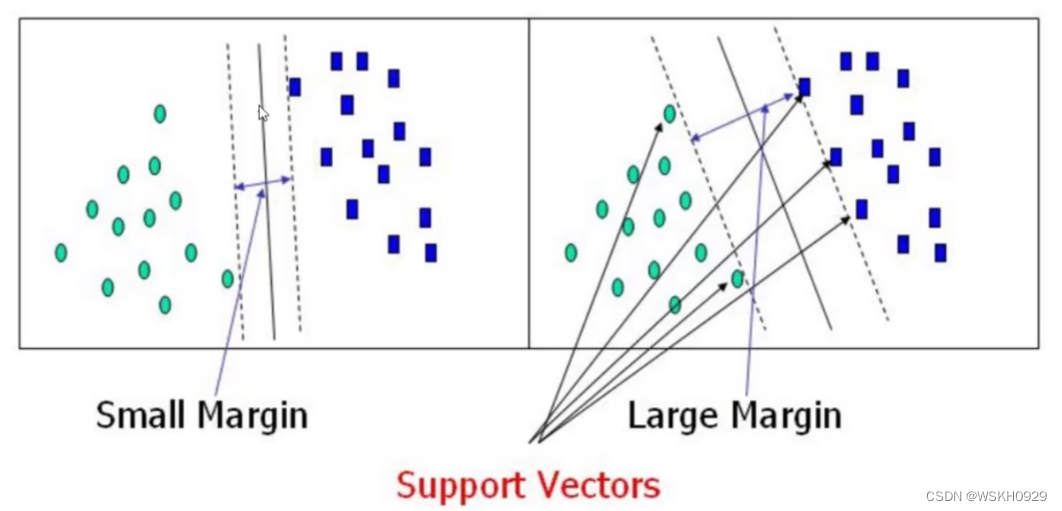
2.2 距离与数据定义
2.2.1 点到平面的距离计算
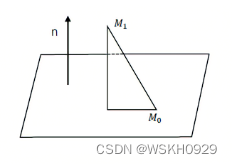
向量法计算点到平面的距离,就是把点和平面放在直角坐标系下进行计算。这样,点 和平面均可用坐标来表示 (如图1所示)。
设平面
Π
Pi
Π 的方程为:
Π
:
A
x
+
B
y
+
C
z
+
D
=
0
Pi: A x+B y+C z+D=0
Π:Ax+By+Cz+D=0
设向量
n
⃗
=
(
A
,
B
,
C
)
vec{n}=(A, B, C)
n=(A,B,C) 为
Π
Pi
Π 的法向量,平面外一点
M
1
M_1
M1 坐标为
(
x
1
,
y
1
,
z
1
)
left(x_1, y_1, z_1right)
(x1,y1,z1) ,在平面 上取一点
M
0
M_0
M0 ,则点
M
1
M_1
M1 到平面
Π
Pi
Π 的距离
d
d
d 为:
d
=
Prj
n
⃗
M
0
M
1
→
=
∥
M
0
M
1
→
∥
cos
α
d=operatorname{Prj}_{vec{n}} overrightarrow{M_0 M_1}=left|overrightarrow{M_0 M_1}right| cos alpha
d=PrjnM0M1=∥
∥M0M1∥
∥cosα
其中
α
alpha
α 为向量
n
⃗
vec{n}
n 与向量
M
0
M
1
→
overrightarrow{M_0 M_1}
M0M1 的夹角,
cos
α
=
M
0
M
1
→
⋅
n
⃗
∥
M
0
M
1
→
∥
⋅
∥
n
⃗
∥
cos alpha=frac{overrightarrow{M_0 M_1} cdot vec{n}}{left|overrightarrow{M_0 M_1}right| cdot|vec{n}|}
cosα=∥
∥M0M1∥
∥⋅∥n∥M0M1⋅n
故
d
=
M
0
M
1
→
⋅
n
⃗
∥
n
⃗
∥
d=frac{overrightarrow{M_0 M_1} cdot vec{n}}{|vec{n}|}
d=∥n∥M0M1⋅n
之后统一用下面的方法对距离进行表示:
distance ( x , b , w ) = ∣ w T ∥ w ∥ ( x − x ′ ) ∣ = 1 ∥ w ∥ ∣ w T x + b ∣ operatorname{distance}(mathbf{x}, b, mathbf{w})=left|frac{mathbf{w}^T}{|mathbf{w}|}left(mathbf{x}-mathbf{x}^{prime}right)right| { = frac{1}{|mathbf{w}|}}left|mathbf{w}^T mathbf{x}+bright| distance(x,b,w)=∣ ∣∥w∥wT(x−x′)∣ ∣=∥w∥1∣ ∣wTx+b∣ ∣
2.2.2 数据标签定义
数据集 : ( X 1 , Y 1 ) ( X 2 , Y 2 ) … ( X n , Y n ) (X 1, Y 1)(X 2, Y 2) ldots(X n, Y n) (X1,Y1)(X2,Y2)…(Xn,Yn)
Y Y Y 为样本的类别: 当 X X X 为正例时候 Y = + 1 Y=+1 Y=+1 当 X X X 为负例时候 Y = − 1 Y=-1 Y=−1
决策方程 : y ( x ) = w T Φ ( x ) + b y(x)=w^T Phi(x)+b y(x)=wTΦ(x)+b ( 其中 Φ ( x ) Phi(x) Φ(x) 是对数据做了变换,后面继续说 )
⇒ y ( x i ) > 0 ⇔ y i = + 1 y ( x i ) < 0 ⇔ y i = − 1 ⇒ > y i ⋅ y ( x i ) > 0 Rightarrow begin{aligned} &yleft(x_iright)>0 Leftrightarrow y_i=+1 \ &yleft(x_iright)<0 Leftrightarrow y_i=-1 end{aligned} quad Rightarrow>y_i cdot yleft(x_iright)>0 ⇒y(xi)>0⇔yi=+1y(xi)<0⇔yi=−1⇒>yi⋅y(xi)>0
可以看出, y i ⋅ y ( x i ) y_i cdot yleft(x_iright) yi⋅y(xi)恒为正数,方便后面直接去掉绝对值
2.3 目标函数推导
优化的目标:找到一条线(w和b),使得离该线最近的点能够最远
将点到直线的距离化简得 :
y
i
⋅
(
w
T
⋅
Φ
(
x
i
)
+
b
)
∥
w
∥
frac{y_i cdotleft(w^T cdot Phileft(x_iright)+bright)}{|w|}
∥w∥yi⋅(wT⋅Φ(xi)+b)
( 由于
y
i
⋅
y
(
x
i
)
>
0
y_i cdot yleft(x_iright)>0
yi⋅y(xi)>0 所以将绝对值展开原始依旧成立 )
放缩变换 : 对于决策方程 ( W , b ) (mathrm{W}, mathrm{b}) (W,b) 可以通过放缩使得其结果值 ∣ Y ∣ > = 1 |mathrm{Y}|>=1 ∣Y∣>=1 ⇒ > y i ⋅ ( w T ⋅ Φ ( x i ) + b ) ≥ 1 Rightarrow>y_i cdotleft(w^T cdot Phileft(x_iright)+bright) geq 1 ⇒>yi⋅(wT⋅Φ(xi)+b)≥1 ( 之前我们认为恒大于0,现在严格了些 )
优化目标 : arg max w , b { 1 ∥ w ∥ min i [ y i ⋅ ( w T ⋅ Φ ( x i ) + b ) ] } underset{w, b}{arg max }left{frac{1}{|w|} min _ileft[y_i cdotleft(w^T cdot Phileft(x_iright)+bright)right]right} w,bargmax{∥w∥1imin[yi⋅(wT⋅Φ(xi)+b)]}
由于 y i ⋅ ( w T ⋅ Φ ( x i ) + b ) ≥ 1 y_i cdotleft(w^T cdot Phileft(x_iright)+bright) geq 1 yi⋅(wT⋅Φ(xi)+b)≥1 ,只需要考虑 arg max w , b 1 ∥ w ∥ underset{w, b}{arg max } frac{1}{|w|} w,bargmax∥w∥1 ( 目标函数搞定!)
2.4 拉格朗日乘子法求解
当前目标 : max w , b 1 ∥ w ∥ max _{w, b} frac{1}{|w|} maxw,b∥w∥1 ,约束条件 : y i ( w T ⋅ Φ ( x i ) + b ) ≥ 1 y_ileft(w^T cdot Phileft(x_iright)+bright) geq 1 yi(wT⋅Φ(xi)+b)≥1
常规套路 : 将求解极大值问题转换成极小值问题 = > m i n w , b 1 2 w 2 =>m i n_{w, b} frac{1}{2} w^2 =>minw,b21w2
如何求解 : 应用拉格朗日乘子法求解
带约束的优化问题:
m
i
n
f
0
(
x
)
s
u
b
j
e
c
t
t
o
f
i
(
x
)
≤
0
,
i
=
1
,
…
m
h
i
(
x
)
=
0
,
i
=
1
,
…
q
begin{aligned} min quad &f_0(x) \ subject quad to quad &f_i(x) leq 0, i=1, ldots m \ &h_i(x)=0, i=1, ldots q end{aligned}
minsubjecttof0(x)fi(x)≤0,i=1,…mhi(x)=0,i=1,…q
原式转换 :
min L ( x , λ , v ) = f 0 ( x ) + ∑ i = 1 m λ i f i ( x ) + ∑ i = 1 q v i h i ( x ) min L(x, lambda, v)=f_0(x)+sum_{i=1}^m lambda_i f_i(x)+sum_{i=1}^q v_i h_i(x) minL(x,λ,v)=f0(x)+i=1∑mλifi(x)+i=1∑qvihi(x)
我们的式子:
L
(
w
,
b
,
α
)
=
1
2
∥
w
∥
2
−
∑
i
=
1
n
α
i
(
y
i
(
w
T
⋅
Φ
(
x
i
)
+
b
)
−
1
)
L(w, b, alpha)=frac{1}{2}|w|^2-sum_{i=1}^n alpha_ileft(y_ileft(w^T cdot Phileft(x_iright)+bright)-1right)
L(w,b,α)=21∥w∥2−i=1∑nαi(yi(wT⋅Φ(xi)+b)−1)
( 约束条件不要忘 :
y
i
(
w
T
⋅
Φ
(
x
i
)
+
b
)
≥
1
)
text { ( 约束条件不要忘 : } left.y_ileft(w^T cdot Phileft(x_iright)+bright) geq 1right)
( 约束条件不要忘 : yi(wT⋅Φ(xi)+b)≥1)
分别对 w w w 和 b求偏导,分别得到两个条件 ( 由于对偶性质)
min w , b max α L ( w , b , α ) → max α min w , b L ( w , b , α ) min _{w, b} max _alpha L(w, b, alpha) rightarrow max _alpha min _{w, b} L(w, b, alpha) w,bminαmaxL(w,b,α)→αmaxw,bminL(w,b,α)
对W求偏导:
∂ L ∂ w = 0 ⇒ w = ∑ i = 1 n α i y i Φ ( x n ) frac{partial L}{partial w}=0 Rightarrow w=sum_{i=1}^n alpha_i y_i Phileft(x_nright) ∂w∂L=0⇒w=i=1∑nαiyiΦ(xn)
对b求偏导:
∂ L ∂ b = 0 ⇒ ∑ i = 1 n α i y i = 0 quad frac{partial L}{partial b}=0 Rightarrow sum_{i=1}^n alpha_i y_i=0 ∂b∂L=0⇒i=1∑nαiyi=0
带入原式 :
L ( w , b , α ) = 1 2 ∥ w ∥ 2 − ∑ i = 1 n α i ( y i ( w T Φ ( x i ) + b ) − 1 ) L(w, b, alpha)=frac{1}{2}|w|^2-sum_{i=1}^n alpha_ileft(y_ileft(w^T Phileft(x_iright)+bright)-1right) L(w,b,α)=21∥w∥2−i=1∑nαi(yi(wTΦ(xi)+b)−1)
其中:
w = ∑ i = 1 n α i y i Φ ( x n ) 0 = ∑ i = 1 n α i y i 原式 = 1 2 w T w − w T ∑ i = 1 n α i y i Φ ( x i ) − b ∑ i = 1 n α i y i + ∑ i = 1 n α i = ∑ i = 1 n α i − 1 2 ( ∑ i = 1 n α i y i Φ ( x i ) ) T ∑ i = 1 n α i y i Φ ( x i ) = ∑ i = 1 n α i − 1 2 ∑ i = 1 , j = 1 n α i α j y i y j Φ T ( x i ) Φ ( x j ) begin{aligned} w&=sum_{i=1}^n alpha_i y_i Phileft(x_nright) quad 0=sum_{i=1}^n alpha_i y_i \ 原式&=frac{1}{2} w^T w-w^T sum_{i=1}^n alpha_i y_i Phileft(x_iright)-b sum_{i=1}^n alpha_i y_i+sum_{i=1}^n alpha_i \ &=sum_{i=1}^n alpha_i-frac{1}{2}left(sum_{i=1}^n alpha_i y_i Phileft(x_iright)right)^T sum_{i=1}^n alpha_i y_i Phileft(x_iright) \ &=sum_{i=1}^n alpha_i-frac{1}{2} sum_{i=1, j=1}^n alpha_i alpha_j y_i y_j Phi^Tleft(x_iright) Phileft(x_jright) end{aligned} w原式=i=1∑nαiyiΦ(xn)0=i=1∑nαiyi=21wTw−wTi=1∑nαiyiΦ(xi)−bi=1∑nαiyi+i=1∑nαi=i=1∑nαi−21(i=1∑nαiyiΦ(xi))Ti=1∑nαiyiΦ(xi)=i=1∑nαi−21i=1,j=1∑nαiαjyiyjΦT(xi)Φ(xj)
继续对 α alpha α 求极大值:
max α ∑ i = 1 n α i − 1 2 ∑ i = 1 n ∑ j = 1 n α i α j y i y j ( Φ ( x i ) ⋅ Φ ( x j ) ) 条件: ∑ i = 1 n α i y i = 0 α i ≥ 0 max _alpha sum_{i=1}^n alpha_i-frac{1}{2} sum_{i=1}^n sum_{j=1}^n alpha_i alpha_j y_i y_jleft(Phileft(x_iright) cdot Phileft(x_jright)right) \ text{条件:} sum_{i=1}^n alpha_i y_i=0 \ alpha_i geq 0 αmaxi=1∑nαi−21i=1∑nj=1∑nαiαjyiyj(Φ(xi)⋅Φ(xj))条件:i=1∑nαiyi=0αi≥0
极大值转换成求极小值 :
min α 1 2 ∑ i = 1 n ∑ j = 1 n α i α j y i y j ( Φ ( x i ) ⋅ Φ ( x j ) ) − ∑ i = 1 n α i 条件: ∑ i = 1 n α i y i = 0 α i ≥ 0 min _alpha frac{1}{2} sum_{i=1}^n sum_{j=1}^n alpha_i alpha_j y_i y_jleft(Phileft(x_iright) cdot Phileft(x_jright)right)-sum_{i=1}^n alpha_i \ text{条件:} sum_{i=1}^n alpha_i y_i=0 \ alpha_i geq 0 αmin21i=1∑nj=1∑nαiαjyiyj(Φ(xi)⋅Φ(xj))−i=1∑nαi条件:i=1∑nαiyi=0αi≥0
2.5 求解决策方程的例子
下面用一个简单的例子来演示决策方程的求解过程:
数据:3个点,其中正例X1(3,3),X2(4,3);负例X3(1,1)
求解 :
1 2 ∑ i = 1 n ∑ j = 1 n α i α j y i y j ( x i ⋅ x j ) − ∑ i = 1 n α i frac{1}{2} sum_{i=1}^n sum_{j=1}^n alpha_i alpha_j y_i y_jleft(x_i cdot x_jright)-sum_{i=1}^n alpha_i 21i=1∑nj=1∑nαiαjyiyj(xi⋅xj)−i=1∑nαi
约束条件 :
α 1 + α 2 − α 3 = 0 α i ≥ 0 , i = 1 , 2 , 3 quad alpha_1+alpha_2-alpha_3=0 \ alpha_i geq 0, quad i=1,2,3 α1+α2−α3=0αi≥0,i=1,2,3
原式:
1 2 ∑ i = 1 n ∑ j = 1 n α i α j y i y j ( x i ⋅ x j ) − ∑ i = 1 n α i frac{1}{2} sum_{i=1}^n sum_{j=1}^n alpha_i alpha_j y_i y_jleft(x_i cdot x_jright)-sum_{i=1}^n alpha_i 21i=1∑nj=1∑nαiαjyiyj(xi⋅xj)−i=1∑nαi
将数据代入:
原式 = 1 2 ( 18 α 1 2 + 25 α 2 2 + 2 α 3 2 + 42 α 1 α 2 − 12 α 1 α 3 − 14 α 2 α 3 ) − α 1 − α 2 − α 3 text{原式}=frac{1}{2}left(18 alpha_1^2+25 alpha_2^2+2 alpha_3^2+42 alpha_1 alpha_2-12 alpha_1 alpha_3-14 alpha_2 alpha_3right)-alpha_1-alpha_2-alpha_3 原式=21(18α12+25α22+2α32+42α1α2−12α1α3−14α2α3)−α1−α2−α3
由于 α 1 + α 2 = α 3 alpha_1+alpha_2=alpha_3 α1+α2=α3 , 化简可得 :
原式 = 4 α 1 2 + 13 2 α 2 2 + 10 α 1 α 2 − 2 α 1 − 2 α 2 text{原式}=4 alpha_1^2+frac{13}{2} alpha_2^2+10 alpha_1 alpha_2-2 alpha_1-2 alpha_2 原式=4α12+213α22+10α1α2−2α1−2α2
分别对 α 1 alpha 1 α1 和 α 2 alpha 2 α2 求偏导,偏导等于0可得:
α 1 = 1.5 , α 2 = − 1 alpha_1=1.5 , alpha_2=-1 α1=1.5,α2=−1
(并不满足约束条件 α i ≥ 0 , i = 1 , 2 , 3 alpha_i geq 0, i=1,2,3 αi≥0,i=1,2,3 ,所以解应在边界上 )
α 1 = 0 , α 2 = − 2 13 ⇒ 带入原式 = − 0.153 ( 不满足约束 ! ) alpha_1=0 , alpha_2=-frac{2}{13} Rightarrow 带入原式 =-0.153 quad(不满足约束!) α1=0,α2=−132⇒带入原式=−0.153(不满足约束!)
α 1 = 0.25 , α 2 = 0 ⟹ 带入原式 = − 0.25 ( 满足约束 ! ) alpha_1=0.25 , alpha_2=0 quad Longrightarrow quad 带入原式 =-0.25 quad( 满足约束 ! ) α1=0.25,α2=0⟹带入原式=−0.25(满足约束!)
综上可得,最小值在 ( 0.25 , 0 , 0.25 ) (0.25,0,0.25) (0.25,0,0.25) 处取得
然后,将 α alpha α 结果带入求解: w = ∑ i = 1 n α i y i Φ ( x n ) w=sum_{i=1}^n alpha_i y_i Phileft(x_nright) w=∑i=1nαiyiΦ(xn)
w = 1 4 ∗ 1 ∗ ( 3 , 3 ) + 1 4 ∗ ( − 1 ) ∗ ( 1 , 1 ) = ( 1 2 , 1 2 ) b = y i − ∑ i = 1 n a i y i ( x i x j ) = 1 − ( 1 4 ∗ 1 ∗ 18 + 1 4 ∗ ( − 1 ) ∗ 6 ) = − 2 begin{aligned} &w=frac{1}{4} * 1 *(3,3)+frac{1}{4} *(-1) *(1,1)=left(frac{1}{2}, frac{1}{2}right) \ &b=y_i-sum_{i=1}^n a_i y_ileft(x_i x_jright)=1-left(frac{1}{4} * 1 * 18+frac{1}{4} *(-1) * 6right)=-2 end{aligned} w=41∗1∗(3,3)+41∗(−1)∗(1,1)=(21,21)b=yi−i=1∑naiyi(xixj)=1−(41∗1∗18+41∗(−1)∗6)=−2
最终,求得平面方程为: 0.5 x 1 + 0.5 x 2 − 2 = 0 0.5 x_1+0.5 x_2-2=0 0.5x1+0.5x2−2=0
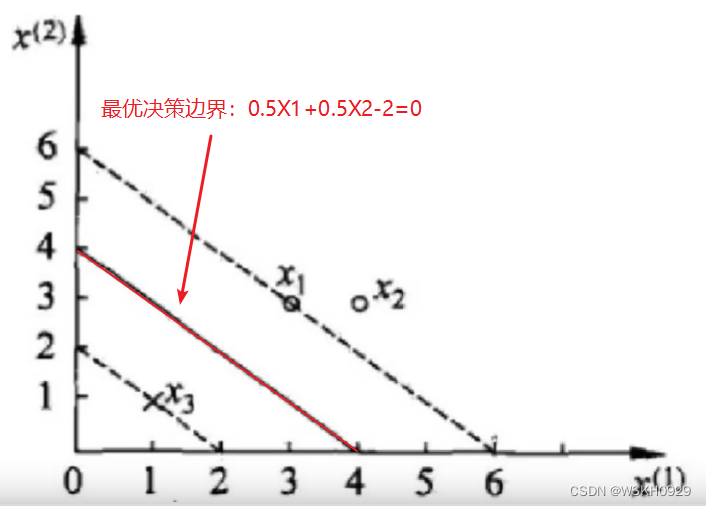
2.6 结合例子深入理解 Support Vertor Machine
结合上面的例子,我们能够更加深入地理解支持向量机。
还记得,在求得的 α alpha α结果中 α 1 = 0.25 , α 2 = 0 , α 3 = 0.25 alpha_1=0.25,alpha_2=0,alpha_3=0.25 α1=0.25,α2=0,α3=0.25
而“巧合”的是,在我们可视化最佳决策边界的图中,我们不难看出,决策边界是由X1和X3所“支撑”起来的,其与X2没有多大关系,所以 α 2 = 0 alpha_2=0 α2=0是可解释的,因为其不影响到决策边界的确定
这也是为什么这个算法被称为“支持向量机”的原因,因为其求解出的决策边界是由n个向量所支持/支撑起来的。
所有 α alpha α值不为0的“边界点”,我们称它们为“支持向量”
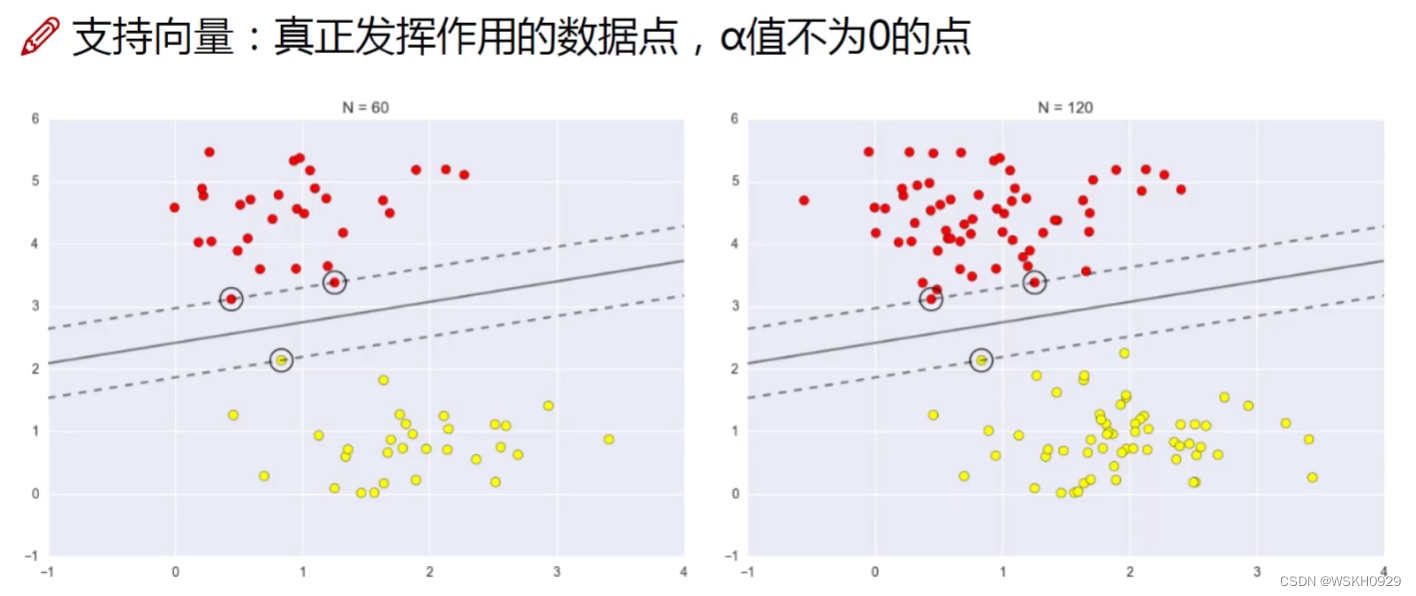
2.6 soft-margin 软间隔
有时候数据中有一些噪音点,如果考虑它们,划分出来的决策边界就不太好了
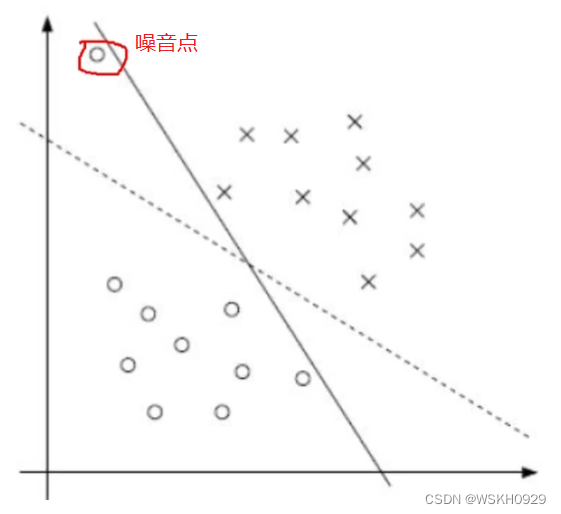
软间隔:之前的方法要求要把两类点完全分得开,这个 要求有点过于严格了,我们来放松一点!
为了解决该问题,引入松弛因子 ξ i xi_i ξi
y i ( w ⋅ x i + b ) ≥ 1 − ξ i y_ileft(w cdot x_i+bright) geq 1-xi_i yi(w⋅xi+b)≥1−ξi
新的目标函数 :
min 1 2 ∥ w ∥ 2 + C ∑ i = 1 n ξ i quad min frac{1}{2}|w|^2+C sum_{i=1}^n xi_i min21∥w∥2+Ci=1∑nξi
- 当C趋近于很大时:意味着分类严格不能有错误
- 当C趋近于很小时:意味着可以有更大的错误容忍
- C是我们需要指定的一个参数!
修改后的拉格朗日乘子法 :
L
(
w
,
b
,
ξ
,
α
,
μ
)
≡
1
2
∥
w
∥
2
+
C
∑
i
=
1
n
ξ
i
−
∑
i
=
1
n
α
i
(
y
i
(
w
⋅
x
i
+
b
)
−
1
+
ξ
i
)
−
∑
i
=
1
n
μ
i
ξ
i
w
=
∑
i
=
1
n
α
i
y
i
ϕ
(
x
n
)
min
α
1
2
∑
i
=
1
n
∑
j
=
1
n
α
i
α
j
y
i
y
j
(
x
i
⋅
x
j
)
−
∑
i
=
1
n
α
i
begin{gathered} L(w, b, xi, alpha, mu) equiv frac{1}{2}|w|^2+C sum_{i=1}^n xi_i-sum_{i=1}^n alpha_ileft(y_ileft(w cdot x_i+bright)-1+xi_iright)-sum_{i=1}^n mu_i xi_i \ w=sum_{i=1}^n alpha_i y_i phileft(x_nright) quad quad min _alpha frac{1}{2} sum_{i=1}^n sum_{j=1}^n alpha_i alpha_j y_i y_jleft(x_i cdot x_jright)-sum_{i=1}^n alpha_i end{gathered}
L(w,b,ξ,α,μ)≡21∥w∥2+Ci=1∑nξi−i=1∑nαi(yi(w⋅xi+b)−1+ξi)−i=1∑nμiξiw=i=1∑nαiyiϕ(xn)αmin21i=1∑nj=1∑nαiαjyiyj(xi⋅xj)−i=1∑nαi
约束:
0
=
∑
i
=
1
n
α
i
y
i
0=sum_{i=1}^n alpha_i y_i quad
0=∑i=1nαiyi 同样的解法:
∑
i
=
1
n
α
i
y
i
=
0
sum_{i=1}^n alpha_i y_i=0
∑i=1nαiyi=0
C
−
α
i
−
μ
i
=
0
α
i
≥
0
μ
i
≥
0
begin{aligned} &C-alpha_i-mu_i=0 \ &alpha_i geq 0 quad mu_i geq 0 end{aligned}
C−αi−μi=0αi≥0μi≥0
0
≤
α
i
≤
C
0 leq alpha_i leq C
0≤αi≤C
2.7 Kernel Function 核函数
低维空间中线性不可分问题
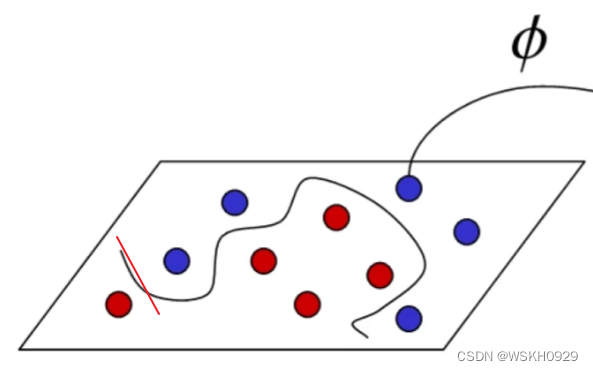
核变换:当低维的时候不可分,那我就给它映射到高维
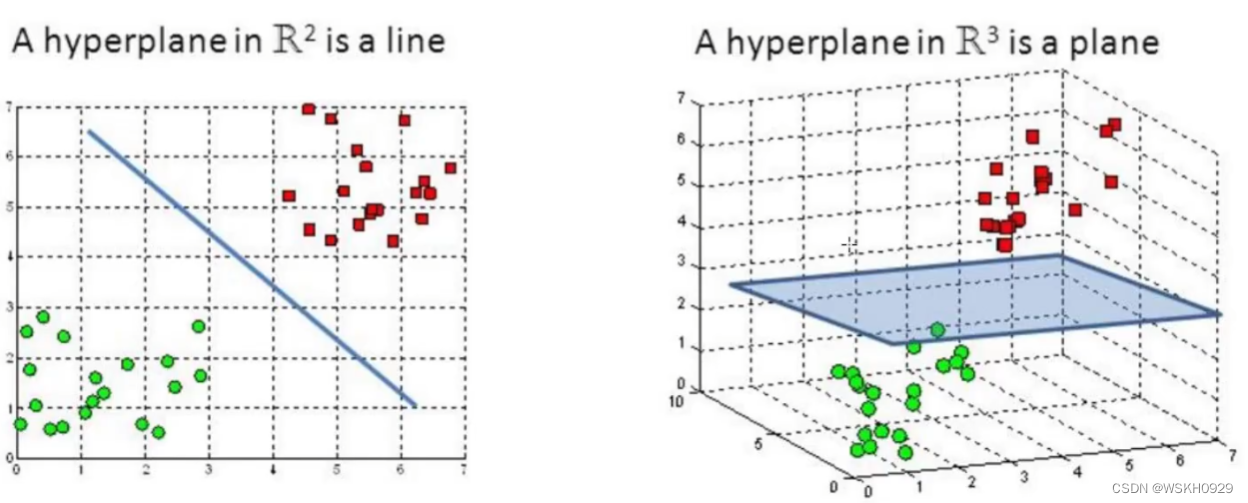
高斯核函数: K ( X , Y ) = exp { − ∥ X − Y ∥ 2 2 σ 2 } K(mathrm{X}, mathrm{Y})=exp left{-frac{|X-Y|^2}{2 sigma^2}right} K(X,Y)=exp{−2σ2∥X−Y∥2}
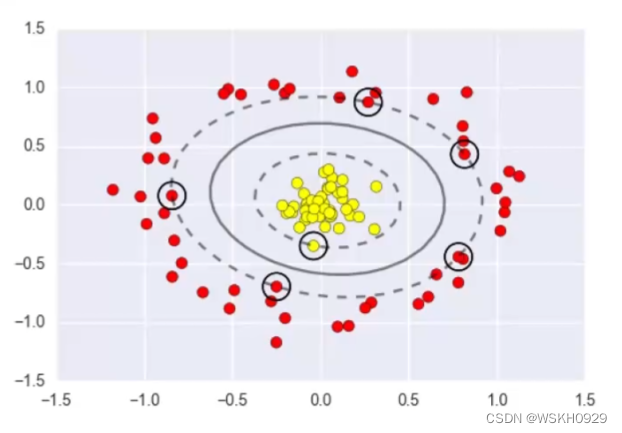
三、Support Vertor Machine 代码实战
3.1 支持向量机效果展示
import warnings
import matplotlib.pyplot as plt
import matplotlib
import numpy as np
import os
%matplotlib inline
plt.rcParams['axes.labelsize'] = 14
plt.rcParams['xtick.labelsize'] = 12
plt.rcParams['ytick.labelsize'] = 12
warnings.filterwarnings('ignore')
from sklearn.svm import SVC
from sklearn import datasets
iris = datasets.load_iris()
X = iris['data'][:, (2, 3)]
y = iris['target']
setosa_or_versicolor = (y == 0) | (y == 1)
X = X[setosa_or_versicolor]
y = y[setosa_or_versicolor]
svm_clf = SVC(kernel='linear', C=float('inf'))
svm_clf.fit(X, y)
# 一般的模型
x0 = np.linspace(0, 5.5, 200)
pred_1 = 5*x0-20
pred_2 = x0 - 1.8
pred_3 = 0.1*x0+0.5
def plot_svc_decision_boundary(svm_clf, xmin, xmax, sv=True):
w = svm_clf.coef_[0]
b = svm_clf.intercept_[0]
x0 = np.linspace(xmin, xmax, 200)
decision_boundary = -w[0]/w[1] * x0 - b/w[1]
margin = 1/w[1]
gutter_up = decision_boundary + margin
gutter_down = decision_boundary - margin
if sv:
svs = svm_clf.support_vectors_
plt.scatter(svs[:, 0], svs[:, 1], s=180, facecolors='#FFAAAA')
plt.plot(x0, decision_boundary, 'k-', linewidth=2)
plt.plot(x0, gutter_up, 'k--', linewidth=2)
plt.plot(x0, gutter_down, 'k--', linewidth=2)
plt.figure(figsize=(14, 4))
plt.subplot(121)
plt.plot(X[:, 0][y == 1], X[:, 1][y == 1], 'bs')
plt.plot(X[:, 0][y == 0], X[:, 1][y == 0], 'ys')
plt.plot(x0, pred_1, 'g--', linewidth=2)
plt.plot(x0, pred_2, 'm-', linewidth=2)
plt.plot(x0, pred_3, 'r-', linewidth=2)
plt.axis([0, 5.5, 0, 2])
plt.subplot(122)
plot_svc_decision_boundary(svm_clf, 0, 5.5)
plt.plot(X[:, 0][y == 1], X[:, 1][y == 1], 'bs')
plt.plot(X[:, 0][y == 0], X[:, 1][y == 0], 'ys')
plt.axis([0, 5.5, 0, 2])

结论:左图为一般线性模型的分类效果,右图为SVM的分类效果,可见SVM的分类效果更好
3.2 软间隔的作用展示
from sklearn.datasets import make_blobs
# 绘图函数
def plot_svc_decision_function(model, ax=None, plot_support=True):
"""Plot the decision function for a 2D SVC"""
if ax is None:
ax = plt.gca()
xlim = ax.get_xlim()
ylim = ax.get_ylim()
# create grid to evaluate model
x = np.linspace(xlim[0], xlim[1], 30)
y = np.linspace(ylim[0], ylim[1], 30)
Y, X = np.meshgrid(y, x)
xy = np.vstack([X.ravel(), Y.ravel()]).T
P = model.decision_function(xy).reshape(X.shape)
# plot decision boundary and margins
ax.contour(X, Y, P, colors='k',
levels=[-1, 0, 1], alpha=0.5,
linestyles=['--', '-', '--'])
# plot support vectors
if plot_support:
ax.scatter(model.support_vectors_[:, 0],
model.support_vectors_[:, 1],
s=300, linewidth=1, facecolors='none')
ax.set_xlim(xlim)
ax.set_ylim(ylim)
# 构造数据
X, y = make_blobs(n_samples=100, centers=2,
random_state=0, cluster_std=0.8)
fig, ax = plt.subplots(1, 2, figsize=(16, 6))
fig.subplots_adjust(left=0.0625, right=0.95, wspace=0.1)
for axi, C in zip(ax, [10.0, 0.1]):
model = SVC(kernel='linear', C=C).fit(X, y)
axi.scatter(model.support_vectors_[:, 0],
model.support_vectors_[:, 1],
s=250, lw=1, facecolors='#AFAAAA',alpha=0.5)
axi.scatter(X[:, 0], X[:, 1], c=y, s=50, cmap='autumn')
plot_svc_decision_function(model, axi)
axi.set_title('C = {0:.1f}'.format(C), size=14)

- 当C趋近于无穷大时:意味着分类严格不能有错误
- 当C趋近于很小的时:意味着可以有更大的错误容忍
3.3 非线性 Support Vertor Machine
from sklearn.datasets import make_moons
from sklearn.pipeline import Pipeline
from sklearn.preprocessing import PolynomialFeatures
from sklearn.preprocessing import StandardScaler
from sklearn.svm import LinearSVC
polynomial_svm_clf = Pipeline((("poly_features", PolynomialFeatures(degree=3)),
("scaler", StandardScaler()),
("svm_clf", LinearSVC(C=10, loss="hinge"))
))
polynomial_svm_clf.fit(X, y)
def plot_predictions(clf, axes):
x0s = np.linspace(axes[0], axes[1], 100)
x1s = np.linspace(axes[2], axes[3], 100)
x0, x1 = np.meshgrid(x0s, x1s)
X = np.c_[x0.ravel(), x1.ravel()]
y_pred = clf.predict(X).reshape(x0.shape)
plt.contourf(x0, x1, y_pred, cmap=plt.cm.brg, alpha=0.2)
plt.plot(X[:, 0][y == 1], X[:, 1][y == 1], 'bs')
plt.plot(X[:, 0][y == 0], X[:, 1][y == 0], 'ys')
plot_predictions(polynomial_svm_clf, [-1.5, 4, -1.5, 6.5])
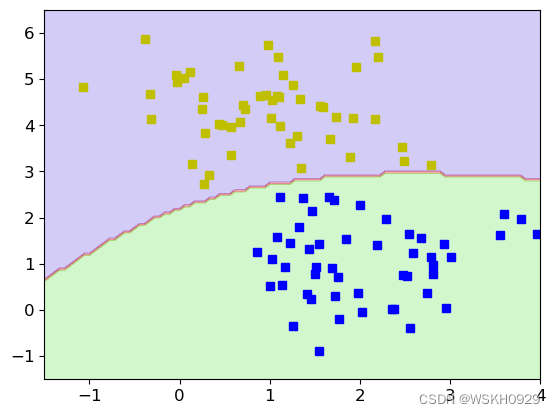
from sklearn.preprocessing import PolynomialFeatures
from sklearn.pipeline import Pipeline
from sklearn.datasets import make_moons
X, y = make_moons(n_samples=100, noise=0.15, random_state=42)
def plot_dataset(X, y, axes):
plt.plot(X[:, 0][y == 0], X[:, 1][y == 0], "bs")
plt.plot(X[:, 0][y == 1], X[:, 1][y == 1], "g")
plt.axis(axes)
plt.grid(True, which='both')
plt.xlabel(r"$x_1$", fontsize=20)
plt.ylabel(r"$x_2$", fontsize=20, rotation=0)
plot_dataset(X, y, [-1.5, 2.5, -1, 1.5])
plt.show()
polynomial_svm_clf = Pipeline((("poly_features", PolynomialFeatures(degree=3)),
("scaler", StandardScaler()),
("svm_clf", LinearSVC(C=10, loss="hinge"))))
polynomial_svm_clf.fit(X, y)
def plot_predictions(clf, axes):
x0s = np.linspace(axes[0], axes[1], 100)
x1s = np.linspace(axes[2], axes[3], 100)
x0, x1 = np.meshgrid(x0s, x1s)
X = np.c_[x0.ravel(), x1.ravel()]
y_pred = clf.predict(X).reshape(x0.shape)
plt.contourf(x0, x1, y_pred, cmap=plt.cm.brg, alpha=0.2)
plt.plot(X[:, 0][y == 1], X[:, 1][y == 1], 'bs')
plt.plot(X[:, 0][y == 0], X[:, 1][y == 0], 'ys')
plot_predictions(polynomial_svm_clf, [-1.5, 2.5, -1, 1.5])
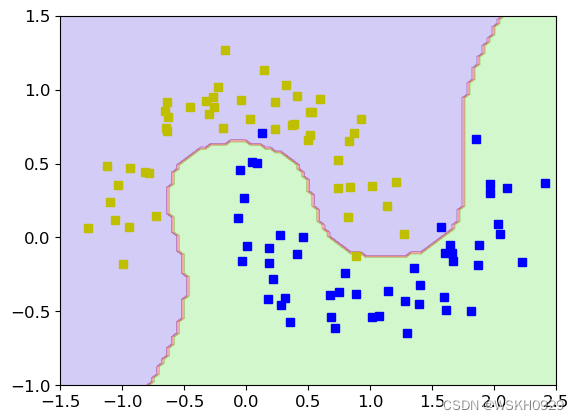
3.4 核函数的作用与效果
from sklearn.svm import SVC
poly_kernel_svm_clf = Pipeline([
("scaler", StandardScaler()),
("svm_clf", SVC(kernel="poly", degree=3, coef0=1, C=5))])
poly_kernel_svm_clf.fit(X, y)
poly100_kernel_svm_clf = Pipeline([
("scaler", StandardScaler()),
("svm_clf", SVC(kernel="poly", degree=10, coef0=100, C=5))])
poly100_kernel_svm_clf.fit(X, y)
plt.figure(figsize=(16,10))
plt.subplot(221)
plt.title("poly, degree=3, coef0=1")
plt.plot(X[:, 0][y == 1], X[:, 1][y == 1], 'bs')
plt.plot(X[:, 0][y == 0], X[:, 1][y == 0], 'ys')
plot_predictions(poly_kernel_svm_clf, [-1.5, 2.5, -1, 1.5])
plt.subplot(222)
plt.title("poly, degree=10, coef0=100")
plt.plot(X[:, 0][y == 1], X[:, 1][y == 1], 'bs')
plt.plot(X[:, 0][y == 0], X[:, 1][y == 0], 'ys')
plot_predictions(poly100_kernel_svm_clf, [-1.5, 2.5, -1, 1.5])
poly_kernel_svm_clf = Pipeline([
("scaler", StandardScaler()),
("svm_clf", SVC(kernel="rbf", degree=3, coef0=1, C=5))])
poly_kernel_svm_clf.fit(X, y)
poly100_kernel_svm_clf = Pipeline([
("scaler", StandardScaler()),
("svm_clf", SVC(kernel="rbf", degree=10, coef0=100, C=5))])
poly100_kernel_svm_clf.fit(X, y)
plt.subplot(223)
plt.title("rbf, degree=3, coef0=1")
plt.plot(X[:, 0][y == 1], X[:, 1][y == 1], 'bs')
plt.plot(X[:, 0][y == 0], X[:, 1][y == 0], 'ys')
plot_predictions(poly_kernel_svm_clf, [-1.5, 2.5, -1, 1.5])
plt.subplot(224)
plt.title("rbf, degree=10, coef0=100")
plt.plot(X[:, 0][y == 1], X[:, 1][y == 1], 'bs')
plt.plot(X[:, 0][y == 0], X[:, 1][y == 0], 'ys')
plot_predictions(poly100_kernel_svm_clf, [-1.5, 2.5, -1, 1.5])
plt.show()
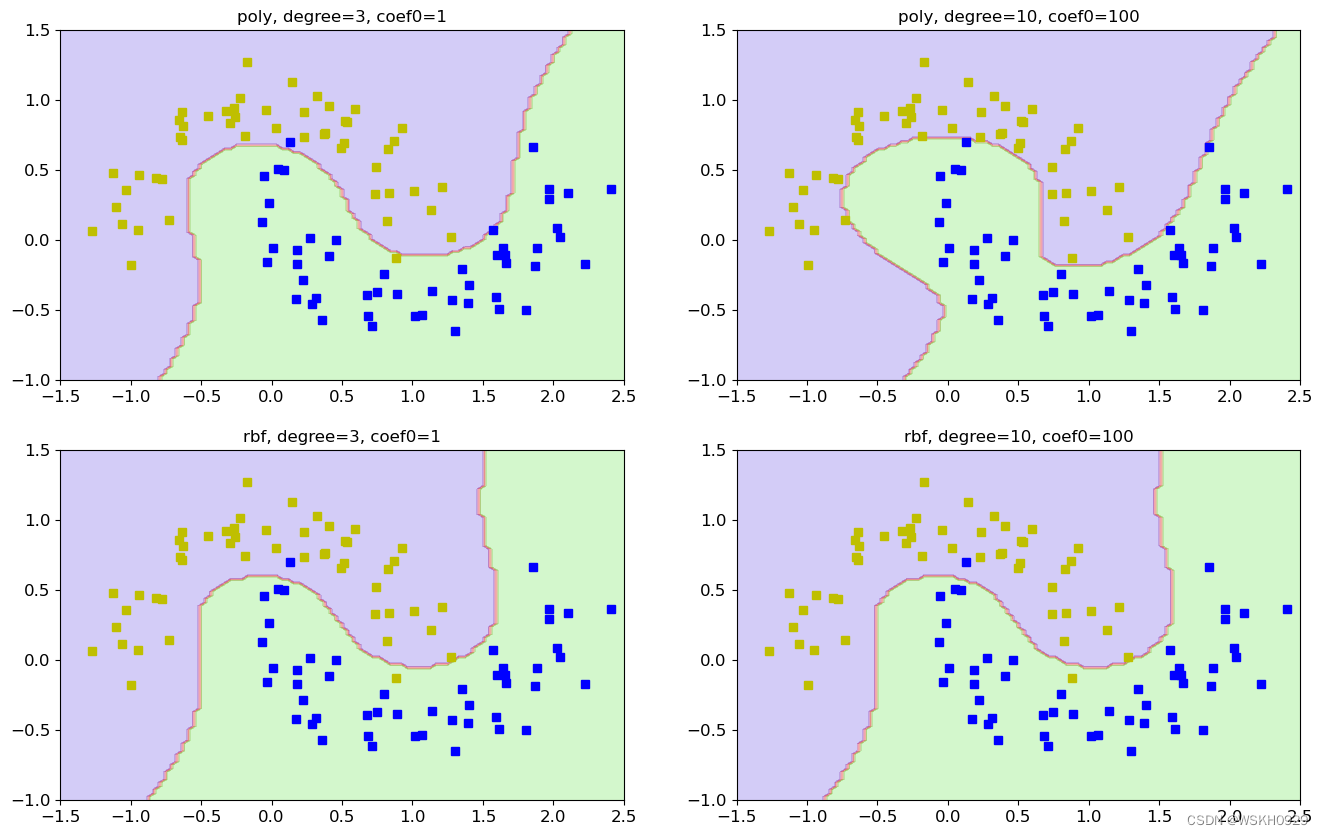
- caef0表示偏置项
- 使用poly核函数的右图的模型过拟合风险更大
- 使用rbf核函数受参数的影响比poly小,并且更不容易过拟合
3.5 Face Recognition 人脸识别案例
作为支持向量机的一个实际例子,让我们来看看面部识别问题。
我们将使用Wild数据集中的Labeled Faces,该数据集包含数千张不同公众人物的整理照片。
数据集的抓取器内置于Scikit Learn中:
3.5.1 获取数据集
from sklearn.datasets import fetch_lfw_people
faces = fetch_lfw_people(min_faces_per_person=60)
print(faces.target_names)
print(faces.images.shape)
输出:
['Ariel Sharon' 'Colin Powell' 'Donald Rumsfeld' 'George W Bush'
'Gerhard Schroeder' 'Hugo Chavez' 'Junichiro Koizumi' 'Tony Blair']
(1348, 62, 47)
3.5.2 查看人脸图像
fig, ax = plt.subplots(3, 5)
for i, axi in enumerate(ax.flat):
axi.imshow(faces.images[i], cmap='bone')
axi.set(xticks=[], yticks=[],
xlabel=faces.target_names[faces.target[i]])

3.5.3 PCA降维
- 每个图的大小是 [62×47]
- 在这里我们就把每一个像素点当成了一个特征,但是这样特征太多了,用PCA降维一下吧!
from sklearn.svm import SVC
#from sklearn.decomposition import RandomizedPCA
from sklearn.decomposition import PCA
from sklearn.pipeline import make_pipeline
pca = PCA(n_components=150, whiten=True, random_state=42)
svc = SVC(kernel='rbf', class_weight='balanced')
model = make_pipeline(pca, svc)
3.5.4 划分训练集和测试集
from sklearn.model_selection import train_test_split
Xtrain, Xtest, ytrain, ytest = train_test_split(faces.data, faces.target,
random_state=40)
3.5.5 网格搜索训练
使用grid search cross-validation来选择较好的参数
from sklearn.model_selection import GridSearchCV
param_grid = {'svc__C': [1, 5, 10],
'svc__gamma': [0.0001, 0.0005, 0.001]}
grid = GridSearchCV(model, param_grid)
%time grid.fit(Xtrain, ytrain)
print(grid.best_params_)
输出:
CPU times: total: 1min 18s
Wall time: 13.3 s
{'svc__C': 5, 'svc__gamma': 0.001}
3.5.6 为模型设置最佳参数并预测图片类别
model = grid.best_estimator_
yfit = model.predict(Xtest)
3.5.7 可视化分类结果
fig, ax = plt.subplots(4, 6)
for i, axi in enumerate(ax.flat):
axi.imshow(Xtest[i].reshape(62, 47), cmap='bone')
axi.set(xticks=[], yticks=[])
axi.set_ylabel(faces.target_names[yfit[i]].split()[-1],
color='black' if yfit[i] == ytest[i] else 'red')
fig.suptitle('Predicted Names; Incorrect Labels in Red', size=14);

3.5.8 输出每个类别预测的准确率、召回率等信息
- 精度(precision) = 正确预测的个数(TP)/被预测正确的个数(TP+FP)
- 召回率(recall)=正确预测的个数(TP)/预测个数(TP+FN)
- F1 = 2精度召回率/(精度+召回率)
from sklearn.metrics import classification_report
print(classification_report(ytest, yfit,
target_names=faces.target_names))
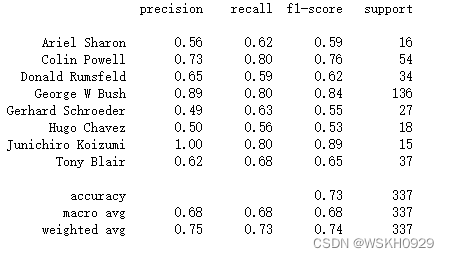
3.5.9 绘制混淆矩阵
from sklearn.metrics import confusion_matrix
import seaborn as sns
mat = confusion_matrix(ytest, yfit)
sns.heatmap(mat.T, square=True, annot=True, fmt='d', cbar=False,
xticklabels=faces.target_names,
yticklabels=faces.target_names)
plt.xlabel('true label')
plt.ylabel('predicted label');
